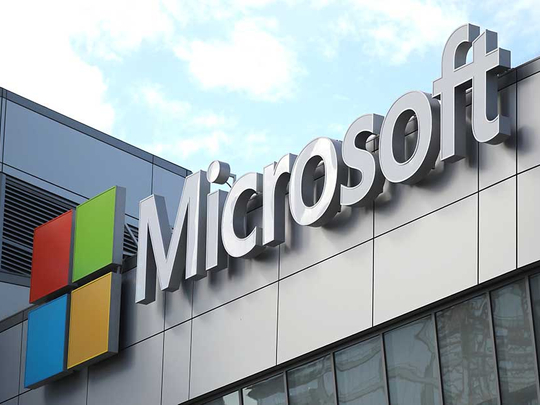
SEATTLE: Microsoft Corp’s cloud-fuelled turnaround persisted in the fiscal fourth quarter, when sales and profit got a boost from customers signing up for more internet-based storage, processing and Office productivity software.
Profit in the period ended June 30 rose to $8.87 billion (Dh32.55 billion), or $1.14 a share, topping the $1.08 average per-share estimate of analysts polled by Bloomberg. Sales climbed 17 per cent to $30.1 billion, Microsoft said Thursday in a statement, higher than predictions for $29.2 billion. Annual sales also topped $100 billion for the first time in company history.
Chief Executive Officer Satya Nadella has been overseeing steady growth in the company’s Azure and Office 365 cloud businesses. Surveys of customer chief information officers by both Morgan Stanley and Sanford C. Bernstein published in the past month show an increase in companies signing up for or planning to use Microsoft’s cloud products. Revenue from cloud-computing platform Azure rose 89 per cent in the quarter, while sales of Web-based Office 365 software to businesses climbed 38 per cent. Microsoft also saw a bump from relative improvements in the corporate personal-computer market, which has been stagnant for years.
“Azure has been hot and Office 365 too,” said Dan Morgan, a senior portfolio manager at Synovus Trust, which owns Microsoft shares. “Microsoft has made huge strides and done wonderful things to turn the company around. They were on a death track with hanging everything on the personal computer.”
Microsoft’s shares rose about 1 per cent in extended trading after the report. They had closed at $104.40 in New York. Stock in the Redmond, Washington-based company rose 8 per cent during the quarter, exceeding the 2.9 per cent increase in the Standard and Poor’s 500 Index. Shares reached new records throughout the period, and have continued to move higher since the quarter’s close.
Commercial cloud sales rose 53 per cent to $6.9 billion, the company said in slides posted on its website. Gross margin for that business widened by 6 percentage points to 58 per cent. Microsoft has been posting improved profitability as it adds customers, enabling it to run services more efficiently and spread costs across more clients. With cloud demand rising, Microsoft has also said it will continue to invest.
During the fourth quarter, the company also agreed to acquire code-sharing website GitHub Inc. for $7.5 billion in stock, aimed at accelerating moves into the cloud and artificial intelligence.
Microsoft’s tally of multimillion-dollar cloud deals was the highest ever in the recent period, Michael Spencer, general manager of investor relations, said in an interview, without providing specifics. Many of those deals included more than one cloud product, he said.
In a Morgan Stanley poll of 100 US and European CIOs, 34 per cent of respondents said they planned to buy a more expensive tier of Office 365 software in the next one to two years. Those using or planning to use Azure rose to more than 70 per cent. Bernstein found 62 per cent of CIOs said they used Azure as of June, up from 50 per cent a little more than a year prior. That compares with 60 per cent for market leader Amazon Web Services and 23 per cent for Google cloud.
Still, the latest quarterly jump in Azure revenue decelerated from the 93 per cent growth Microsoft posted in the prior period. Market-share surveys generally show Azure lagging far behind Amazon, which is at least three times bigger by that measure. The two companies are adding new cloud services and duking it out for customers as No 3 US player Google tries to catch up. Earlier this week, Microsoft said Walmart Inc, an Amazon retail rival, signed a five-year cloud deal involving Azure and Office 365.
Sales of Intelligent Cloud products — Azure and server software — rose 23 per cent to $9.61 billion, above the $9.07 billion average estimate of four analysts polled by Bloomberg. Productivity software, mainly Office sales, rose 13 per cent to $9.67 billion. That compares with the $9.64 billion average estimate.
While Microsoft has reorganised its structure and de-emphasised its Windows PC operating system efforts — once the company’s flagship business — corporate sales of the software still generate considerable revenue. That means the company benefited as PC shipments rose last quarter for the first time in six years, owing to strength in the business segment, which helped make up for continued declines among consumers, according to Gartner Inc. In the fourth quarter, revenue in the More Personal Computing unit rose 17 per cent to $10.8 billion, compared with a $10.5 billion average estimate.
Surface hardware sales rose 25 per cent from a year ago, and gaming revenue increased 39 per cent, fuelled by demand for third-party titles for the Xbox console. Gaming revenue for the full year topped $10 billion for the first time.
As the US places tariffs on some foreign goods and countries retaliate with taxes of their own, Microsoft is keeping an eye on the issue, Spencer said.
“We operate globally so any time there’s trade wars, so to speak, we don’t like to see them,” he said. “In China we have good partnerships with companies there and always looking for ways to expand. There’s nothing that’s of concern right now, but we are watching it closely.”












